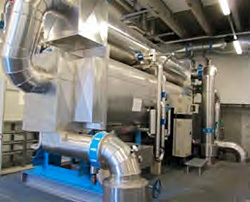Saves energy and cuts carbon emissions
Saves energy and cuts carbon emissions
The Danish Board of District Heating (DBDH) in a story that appeared in the October issue of its newsletter, has reported that despite its extremely mild summers, Copenhagen, needs air conditioning in office buildings with large server rooms or work places and shopping centres accommodating a large number of people. In the light of this, it has efficiently tapped its seawater for district cooling.
Gerdes reported that two years ago, Copenhagen Energy (Københavns Energi) opened the city’s first district cooling plant, a 10-megawatt (MW) facility located on the site of an obsolete power plant on Adelgade, to complement the city’s existing district heating system, which is reportedly the world’s largest, covering 98% of Copenhagen.
Gerdes, who was on a reporting trip to Denmark, was given a guided tour of the plant by Thomas Grinde, an engineer with Copenhagen Energy, who explained how the system works: When the temperature of the water in Copenhagen Harbour is sufficiently cold, the district cooling system draws water from an intake pipe located near the Royal Danish Playhouse and Nyhavn Canal. Care is taken to separate small marine life at the intake and introduce into a suitable habitat. Every degree saved by pre-cooling with seawater, reportedly saves 15% on electricity at the chiller.

View of Copenhagen district cooling facility (Photo: Justin Gerdes)
The following are claimed to be the advantages of diverting seawater for DC:
With rising summer temperatures, Gerdes said, Copenhagen expects cooling demand to increase in the coming decades and the need for as many as seven district cooling zones.
Copyright © 2006-2025 - CPI Industry. All rights reserved.